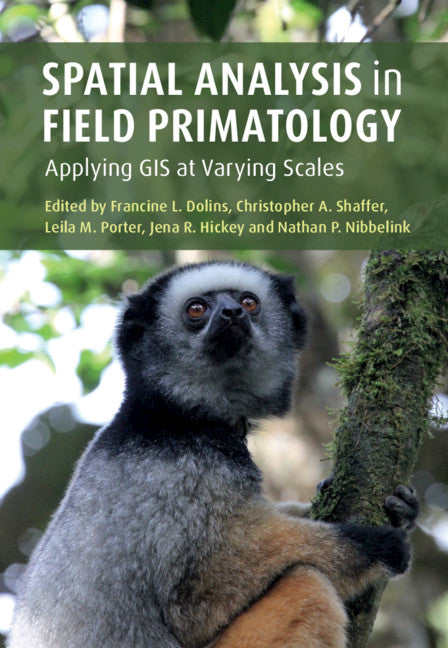Freshly Printed - allow 4 days lead
Couldn't load pickup availability
Spatial Analysis in Field Primatology
Applying GIS at Varying Scales
A primatologist's guide to using geographic information systems (GIS); from mapping and field accuracy, to tracking travel routes and the impact of logging.
Francine L. Dolins (Edited by), Christopher A. Shaffer (Edited by), Leila M. Porter (Edited by), Jena R. Hickey (Edited by), Nathan P. Nibbelink (Edited by)
9781107062306, Cambridge University Press
Hardback, published 18 February 2021
460 pages, 95 b/w illus. 24 colour illus. 42 tables
25 x 17.5 x 2.6 cm, 1.08 kg
'… the editors provide an excellent primer on GPS and GIS fundamentals that deftly expands to include research findings using more advanced methods. This resource covers applications of GPS and GIS directly relevant to readers from many areas of conservation biology who already use or want to use telemetry, GPS, or GIS analysis. This reviewer recommends the volume to any interested reader: it is not just for primatologists and will be an excellent reference for all researchers and students with biogeography, wildlife management, or technical GIS interests. Highly recommended.' C.A. Badurek, Choice
From foraging patterns in a single tree to social interactions across a home range, how primates use space is a key question in the field of primate behavioral ecology. Drawing on the latest advances in spatial analysis tools, this book offers practical guidance on applying geographic information systems (GIS) to central questions in primatology. An initial methodological section discusses niche modelling, home range analysis and agent-based modelling, with a focus on remote data collection. Research-based chapters demonstrate how ecologists apply this technology to a suite of topics including: calculating the intensity of use of both range and travel routes, assessing the impacts of logging, mining and hunting, and informing conservation strategies.
Part I. GPS for Primatologists: Introduction Leila M. Porter
1. Why place matters, and its use in primate behavioral and ecological research Francine L. Dolins
2. Fundamentals of GPS AND GIS Nathan P. Nibbelink and Joanna Hatt
3. 'Next-gen' tracking in primatology: opportunities and challenges Margaret C. Crofoot
4. The ethical implications, and practical consequences, of attaching remote telemetry apparatus to macaques Amy Klegarth, Agustín Fuentes, Lisa Jones-Engel, Greg Marshall and Kyler Abernathy
5. Processing geospatial data in R: a primer Allison Howard and Roger Mundry
6. Estimating travel distance and linearity of primate routes: ideas on how to clean and smooth track data collected with a handheld GPS Karline R. L. Janmaat, Simone D. Ban and Roger Mundry
Part II. GIS Analysis in Fine-Scale Space: Introduction Christopher A. Shaffer
7. Home range analysis: why the methods matter Sarah A. Boyle
8. Quantifying resource dispersion in free-ranging bearded sakis in Guyana: what is a patch? Christopher A. Shaffer
9. Interpreting small-scale patterns of ranging by primates: what does it mean, and why does it matter? Mitchell T. Irwin and Jean-Luc Raharison
10. Determining the presence of habitual travel route networks in orangutans (pongo pygmaeus morio) in Kutai National Park, Borneo Adam O. Bebko
11. Finding fruit in a tropical rainforest: a comparison of the foraging patterns of two distinct fruit-eating primates across years Leila M. Porter, Paul Garber, Christopher Boesch and Karline R. L. Janmaat
12. Random walk analyses in primates Amy L. Schreier and Matt Grove
13. The use of small-scale spatial analysis to evaluate primate behavior and welfare in captive settings Stephen R. Ross and Marisa A. Shender
14. The promise of spatially explicit agent-based models for primatology research Anthony Di Fiore
Part III. GIS Analysis in Broad-Scale Space: Introduction Francine L. Dolins
15. Modeling niches and mapping distributions: progress and promise of ecological niche models for primate research Kenneth L. Chiou and Mary E. Blair
16. Does reduced habitat quality or increased hunter access explain defaunation of fragmented forests? Bonobos as a case study Jena R. Hickey and Michael J. Conroy
17. Landscape ecology of deforestation processes and lemur biogeography in Madagascar Travis S. Steffens and Shawn M. Lehman
18. Quantitative methods for primate biogeography and macroecology Jason M. Kamilar and Lydia Beaudrot
19. GIS and GPS techniques in an ethnoprimatological investigation of St Kitts green monkey (chlorocebus sabaeus) crop-foraging behavior Kerry M. Dore, Daniel Sewell, Eduardo M. Mattenet and Trudy R. Turner
20. Conclusion Francine L. Dolins.
Subject Areas: Environmental science, engineering & technology [TQ], Conservation of wildlife & habitats [RNKH], Environmentalist, conservationist & Green organizations [RNB], Geographical information systems [GIS & remote sensing RGW], Primates [PSVW79], Animal ecology [PSVS], Animal behaviour [PSVP], Anthropology [JHM]


